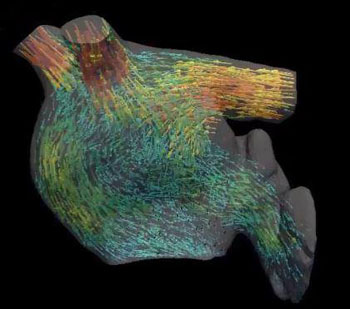Specialized CT Scans Could Predict Stroke Risk
By Andrew Deutsch
Posted on 22 Nov 2016
The results of a new proof-of-concept study show that the blood flow in corkscrew-like eddies through the upper left chamber of the heart may help predict the chance of a patient suffering a stroke.Posted on 22 Nov 2016
The researchers used specialized Computed Tomography (CT) scans to compare the blood flow in the left atria of a 58-year-old woman with a healthy heart, and a 68-year-old man with heart disease and an enlarged heart, both had a history of atrial fibrillation. The results were published in the November 2016 print issue of Annals of Biomedical Engineering.

Image: The trajectory of blood flowing into the left atrium from the pulmonary veins (Photo courtesy of Hiroshi Ashikaga).
The research team consisted of cardiologists and biomedical engineers from Johns Hopkins University School of Medicine (Baltimore, MD, USA). They created computer models and visualizations of blood flow in the atrium that showed that a diseased heart lacks the tight corkscrew-like "eddies” that move blood out of the heart efficiently, and this increases the risk of developing a blood clot. According to the researchers, the new method could enable clinicians in the future to predict the stroke risk in people with enlarged and weakened heart muscle.
Hiroshi-Ashikaga, MD, PhD, assistant professor of medicine, said, "By looking at blood flow through the atrium, we think we can accurately assess stroke risk better than such risk factors as heart size and pumping strength. Our study fills in a missing diagnostic link between heart function and fluid motion in our understanding of how each can affect stroke risk. As the blood comes in contact with the atrium's surface, it slows down due to shearing forces similar to friction, and this appears to prevent the blood from exiting the chamber as smoothly as it might. The slower the blood moves and the more contact it has with the atrium, the more risk there is for a clot to form."
Related Links:
Johns Hopkins University School of Medicine














